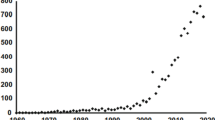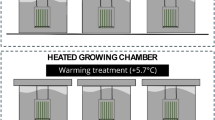Abstract
The effect of nutrient (N, P, and Si) depletion on sinking rates was studied for two small (Skeletonema costatum (Grev.) Cleve and Chaetoceros gracile Schütt) and two large [Ditylum brightwellii (West) Grun and Coscinodiscus wailesii (Gran et Angst)] centric diatoms obtained from stock cultures. Each diatom was examined under conditions of (1) nutrient repletion (=log growth phase), (2) nutrient depletion (48 h without a given substrate), and (3) recovery (24h after addition of limiting substrate to nutrient-deplete populations). All nutrient-replete cultures displayed low sinking rates despite large differences in cell size. In nutrient-deplete populations, sinking rate was related to the kind of nutrient depleted and varied among species. Silicate depletion elicited by far the greatest increase in sinking rates in all 4 species, indicating that biochemical aspects of silicon metabolism are more important to buoyancy regulation than density-related variations in the amount of silicon per cell. Since N- and P-depletion caused lower sinking rates in 3 of the species, this observation calls for re-evaluation of the axiom that nutrient depletion necessarily causes increased sinking rates. The exception was Coscinodiscus wailesii, which sank faster under all types of nutrient limitation. In most cases, sinking rates typical of log-phase cultures were not regained within 24 h after the addition of limiting nutrient to nutrient-depleted populations. Ultimately, the length of the recovery period may be useful in identifying the metabolic processes responsible for buoyancy regulation in actively growing cells.
Similar content being viewed by others
Literature Cited
Armstrong, F. A. J., C. R. Stearns and J. D. H. Strickland: Measurement of upwelling and subsequent biological processes by means of the Technicon AutoAnalyzer and associated equipment. Deep-Sea Res. 14, 381–389 (1967)
Anderson, L. and B. Sweeney: Diel changes in the sedimentation characteristics of Ditylum brightwellii, a marine centric diatom: changes in cellular lipid and effects of respiratory inhibitors and ion-transport modifiers. Limnol. Oceanogr. 22, 539–552 (1977)
Anderson L. and B. Sweeney: Role of inorganic ions in controlling sedimentation rate of a marine centric diatom Ditylum brightwellii. J. Phycol. 14, 204–214 (1978)
Bhovichitra, M. and E. Swift: Light and dark uptake of nitrate and ammonium by large oceanic dinoflagellates: Pyrocystis noctiluca, Pyrocystis fusiformis and Dissodinium lunula. Limnol. Oceanogr. 22, 73–83 (1977)
Bienfang, P. K.: Sinking rate dynamics of Cricosphaera carterae Braarud. I. Effects of growth rate, limiting substrate, and diurnal variation in steady-state populations. J. exp. mar. Biol. Ecol. 49, 217–233 (1981a)
Bienfang, P. K.: Sinking rate dynamics of Cricosphaera carterae Braarud. II. Senescence response to various limiting substrates in non-steady-state populations. J. exp. mar. Biol. Ecol. 49, 235–244 (1981b)
Bienfang, P. K.: Sinking rates of heterogeneous, temperate phytoplankton populations. J. Plankton Res. 3, 235–253 (1981c)
Bienfang, P. K.: SETCOL—a technologically simple and reliable method for measuring phytoplankton sinking rates. Can. J. Fish. aquat. Sciences 38, 1289–1294 (1981d)
Bienfang, P. K., E. Laws and W. Johnson: Phytoplankton sinking rate determination: technical and theoretical aspects, and improved methodology. J. exp. mar. Biol. Ecol. 30, 283–300 (1977)
Davis, C. O., J. T. Hollibaugh, D. L. Seibert, W. H. Thomas and P. J. Harrison: Formation of resting spores by Leptocylindrus danicus (Bacillariophyceae) in a controlled experimental ecosystem. J. Phycol. 16, 296–302 (1980)
Eppley, R. W., R. W. Holmes and E. Paasche: Periodicity in cell division and physiological behavior of Ditylum brightwellii, a marine planktonic diatom, during growth in light-dark cycles. Arch. Mikrobiol. 56, 305–323 (1967a)
Eppley, R. W., R. W. Holmes and J. D. H. Strickland: Sinking rates of marine phytoplankton measured with a fluorometer. J. exp. mar. Biol. Ecol. 1, 191–208 (1967b)
Eppley, R. W., J. N. Rogers and J. J. McCarthy: Half-saturation constants for uptake of nitrate and ammonium by marine phytoplankton. Limnol. Oceanogr. 14, 912–920 (1969)
Finenko, Z. Z. and D. K. Krupatkina-Akinina: Effect of inorganic phosphorus on the growth rate of diatoms. Mar. Biol. 26, 193–201 (1974)
Gross, F. and E. Zeuthen: The buoyancy of plankton diatoms; a problem of cell physiology. Proc. R. Soc. (Ser. B) 135, 382–389 (1948)
Hager, F. W., L. I. Gordon and J. K. Park: A practical manual for the use of the Technicon AutoAnalyzer in seawater nutrient analysis. Tech. Rep. Dep. Oceanogr. Ore. St. Univ., Corvallis 68–33, 1–31 (1968)
Hallegraeff, G. M.: Seasonal study of phytoplankton pigments and species at a coastal station off Sydney: importance of diatoms and the nanoplankton. Mar. Biol. 61, 107–118 (1981)
Harrison, P. J., H. L. Conway, R. W. Holmes and C. O. Davis: Marine diatoms grown in chemostats under silicate or ammonium limitation. III. Cellular chemical composition and morphology of Chaetoceros debilis, Skeletonema costatum and Thalassiosira gravida. Mar. Biol. 43, 19–31 (1977)
Harrison, P. J., R. W. Waters and F. J. R. Taylor: A broad spectrum artificial seawater medium for coastal and open ocean phytoplankton. J. Phycol. 16, 28–35 (1980)
Jeffrey, S. W. and S. M. Carpenter: Seasonal succession of phytoplankton at a coastal station off Sydney. Austr. J. mar. Freshwat. Res. 25, 361–369 (1974)
Lännergren, C.: Buoyancy of natural populations of marine plankton. Mar. Biol. 54, 1–10 (1979)
Murphy, J. and J. P. Riley: A modified simple solution method for the determination of phosphate in natural waters. Analytica chim. Acta 27, 31–36 (1962)
Pasche, E.: silicon and the ecology of marine plankton diatoms. II. Silicate-uptake kinetics in five diatom species. Mar. Biol. 19, 262–269 (1973)
Smayda, T. J.: The suspension and sinking of phytoplankton in the sea. Oceanogr. mar. Biol. A. Rev. 8, 353–414 (1970)
Smayda, T. J. and B. J. Boleyn: Experimental observations on the flotation of marine diatoms. II. Skeletonema costatum and Rhizosolenia setigera. Limnol. Oceanogr. 11, 18–34 (1966a)
Smayda, T. J. and B. J. Boleyn: Experimental observations on the flotation of marine diatoms. III. Bacteriastrum hyalinum and Chaetoceros lauderi. Limnol. Oceanogr. 11, 35–43 (1966b)
Steele, J. H. and C. S. Yentsch: The vertical distribution of chlorophyll. J. mar. biol. Ass. U.K. 39, 217–226 (1960)
Takahashi, M., D. L. Seibert and W. H. Thomas: Occasional blooms of phytoplankton during summer in Saanich Inlet, B. C. Canada. Deep-Sea Res. 24, 775–780 (1977)
Thomas, W. H. and A. N. Dodson: Effects of phosphate concentration on cell division rates and yield of a tropical oceanic diatom. Biol. Bull. mar. biol. Lab., Woods Hole 134, 199–208 (1968)
Thomas, W. H. and A. N. Dodson: On silica acid limitation of diatoms in near surface waters of the eastern tropical Pacific Ocean. Deep-Sea Res. 22, 671–677 (1975)
Titman, D.: A fluorometric technique for measuring sinking rates of fresh-water phytoplankton. Limnol. Oceanogr. 20, 869–875 (1975)
Werner, D.: Silicate metabolism. Bot. Monogr. 13, 110–149 (1977)
Author information
Authors and Affiliations
Additional information
Communicated by N. D. Holland, La Jolla
Rights and permissions
About this article
Cite this article
Bienfang, P.K., Harrison, P.J. & Quarmby, L.M. Sinking rate response to depletion of nitrate, phosphate and silicate in four marine diatoms. Marine Biology 67, 295–302 (1982). https://doi.org/10.1007/BF00397670
Accepted:
Issue Date:
DOI: https://doi.org/10.1007/BF00397670




